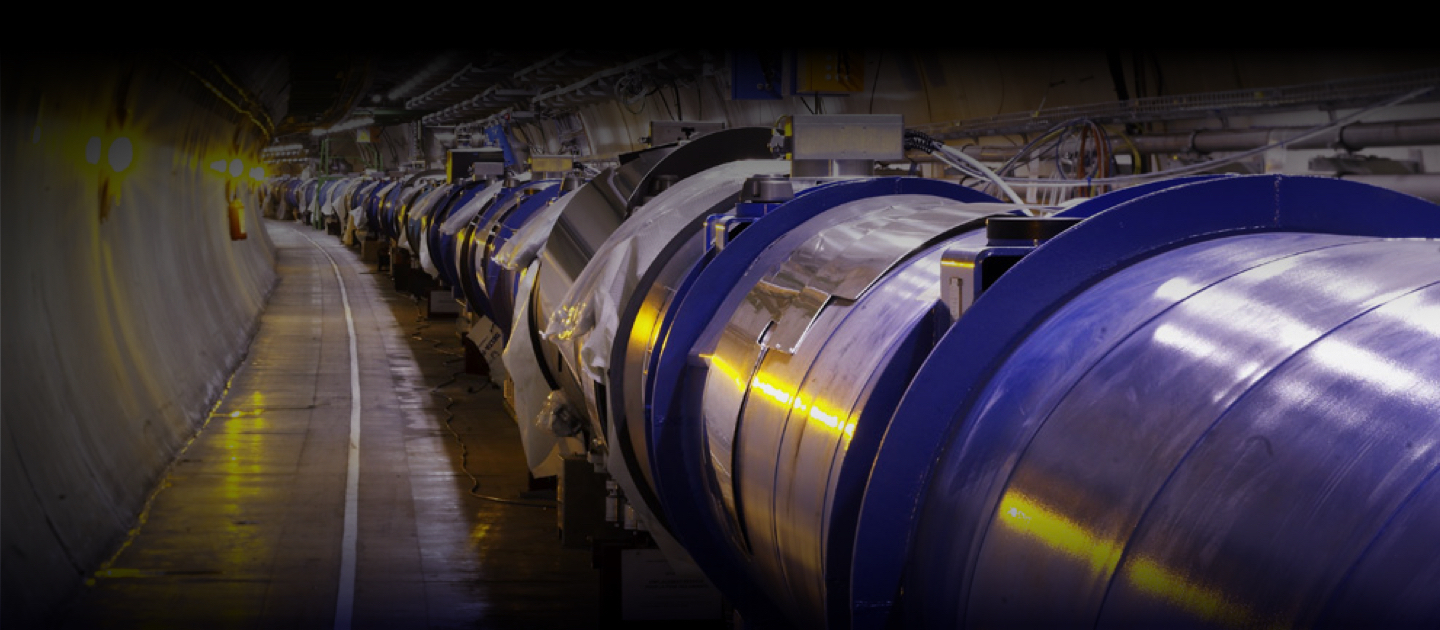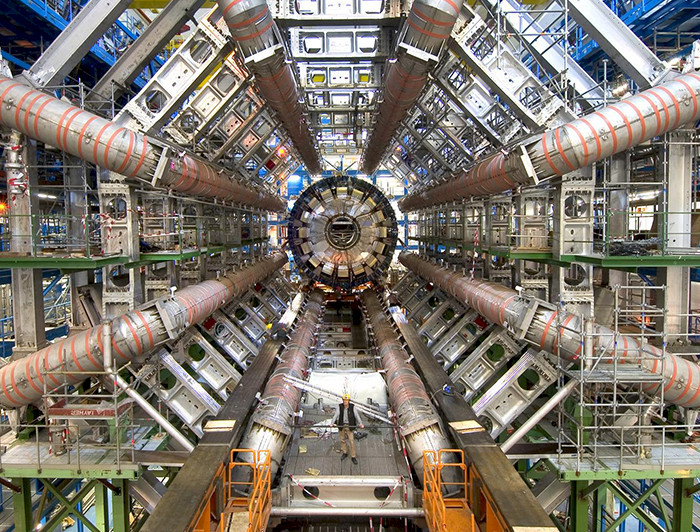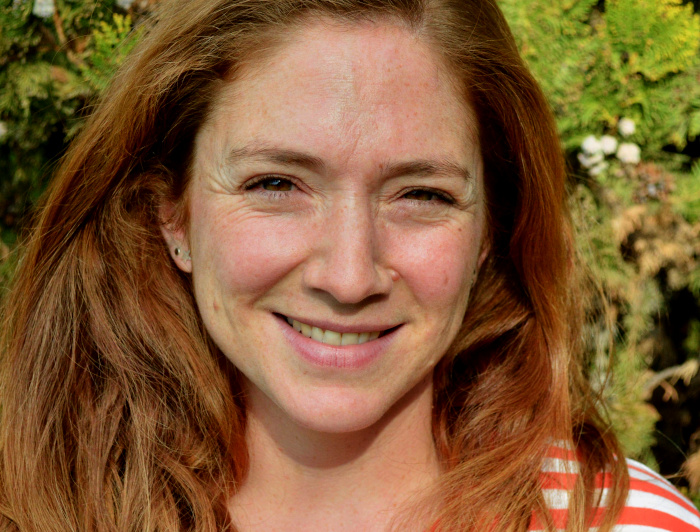
SAPHIR Millennium Institute: what are we made of at a fundamental particle level?
Where did matter come from? What are the laws that govern the subatomic world? What can technological applications be developed from Particle Physics? These are some of the critical issues that gave rise to this Institute. Professor Francisca Garay of the Faculty of Physics is the alternate director.

photo_camera The group of faculty members behind SAPHIR is the only team of physicists from Latin America selected to work on the upgrade of the ATLAS experiment (pictured). It is part of the activities around the Large Hadron Collider, the largest and highest-energy particle accelerator in the world. (Credit: CERN)
At the end of last year, the new Millennium Institute for Subatomic Physics at the High Energy Frontier (SAPHIR) was one of the proposals awarded through the National Research and Development Agency (ANID Spanish acronym) competition for the creation of Millennium Institutes in Natural and Exact Sciences. This inter-institutional research center of excellence is led by Sergey Kuleshov, professor of Universidad Andrés Bello, and Francisca Garay, professor of the UC Chile Faculty of Physics, as an alternate director.
Because of its inter-institutional nature, faculty members from Universidad Técnica Federico Santa María (UTFSM), Universidad de La Serena (ULS), and Universidad de Tarapacá (UTA) will also participate in SAPHIR.
"It was time to combine efforts in this area in Chile," said Francisca Garay. According to the UC Chile professor, this application was born from the need to acquire funds to complete and maintain local commitments with projects for the ATLAS detector. This detector is part of the Large Hadron Collider (LHC), the most significant and highest-energy particle accelerator and human-built machine on Earth.
"The SAPHIR team invited me to participate as an alternate director, which is a great honor, so I immediately accepted," she said.
Watch the BBC's tour inside the Large Hadron Collider:
After a long period of hard work and many sleepless hours, the team came up with a proposal for the SAPHIR Institute.
"Several months later, they informed us that we had been selected for the interview. It was around the time of the national holiday, so we worked hard on our presentation with an empanada in one hand and the computer in the other," recalled the UC Chile professor. She also highlighted the support from both UC Chile and UNAB.
In December, we received a green light for the team's proposal, which was fantastic news. All the work was worth it.
"For me, it was unbelievable because this was the result of years of effort. Because some researchers took me under their wings so that high energy physics could be a field of physics that can contribute to Chile," she said.
However, this is only the beginning. The challenge now is to make this field even more established to be as recognized as astronomy in ten years' time today.
A contribution to human knowledge and new technologies
The main objective of this new Institute will be to understand what we are made of at a fundamental level. And how these particles interact with each other. As Francisca explained, "to access this fundamental micro-world, we need high-energy physics. We need to collide protons at high energies to access their fundamental parts."
These collisions occur at the Large Hadron Collider.
Particle physics —AKA high-energy physics— is a field that explores the frontiers of knowledge. They are searching for new ideas and experimental facts that will lead to a "final theory." A theory capable of explaining with a single great equation all the phenomena of the Universe —longing on the minds of many physicists, including Albert Einstein.
Garay recalled an analogy made by Rafael Carreras, a renowned researcher of the European Organization for Nuclear Research(or CERN for its acronym in French), in a publication entitled "How energy becomes matter".
"If we stage a head-on collision between two strawberries, the number of strawberry pieces that come out will depend on the speed of the collision. If the speed is low, they will probably split in two, but we will see seeds shooting out if it is high. If we do this with the energies of the Large Hadron Collider, bizarre things will happen. In the case of strawberries, not just seeds would come out, but also lemons, pears, apples, and even more strawberries," she explained.
On the more practical side, "all the technology needed to achieve these high-energy collisions and to be able to detect everything that comes out, is impressive." Part of this technology, for example, is the small Strip Thin Gap Chambers (sTGC) muon type detectors —a muon is an elementary particle similar to the electron but with a larger mass.
"These detectors could be used in mining to make CT scans (an industrial computed tomography) of the subsoil. Miners can find underground water channels without having to drill holes, avoiding accidents, just using muon, a subatomic particle that comes from cosmic rays," she added.
On the other hand, according to Garay, it is vital to mention applications in medicine.
"Colleagues from the University Federico Santa María created the intraoperative gamma probe. It is a radioactivity detector that is being used by medical personnel from the UC Christus Health Network. These are some of the areas that SAPHIR wants to explore," she added.
Moreover, one of its main contributions is the training of Chilean experts: students from related programs and technical personnel can be trained here.
The beginning of the journey

"It all started with my parents. They noticed my love for science when I was 13 years old."
Soon after, they enrolled her in an astronomy course at the Chilean Association of Astronomy and Astronautics (ACHAYA Spanish acronym). From there, it was a path of no return.
Francisca studied her undergraduate and master's degree in Physics at UC Chile. Then she did a Ph.D. in Experimental Particle Physics at the University of Edinburgh in the United Kingdom.
When Professor Garay returned, she found a complicated scenario in Chile, as it was hard to get funding. She worked at Universidad Mayor as a professor and as a young researcher at Fundación Ciencia y Vida.
This whole path "opened my mind," said Garay.
She returned to particle physics as a postdoctoral fellow at the UC Chile Faculty of Physics. Shortly after, she joined as an assistant professor.
She participated in the ATLAS experiment at the Large Hadron Collider and the future Compact Linear Collider (CLIC) experiment, both at the European Organization for Nuclear Research (CERN) laboratory in Switzerland.
A contribution from Latin America
Through this Institute, there is an indispensable focus on collaboration with the European Organization for Nuclear Research, especially from South America. It is the only team of physicists from Latin America selected to work on the 2020 upgrade of the ATLAS experiment, part of the activities around the Large Hadron Collider.
"CERN does not need us. They will continue to do frontier research with or without Chile. But we need them to learn and train ourselves. To be part of what is being done outside to bring it to the country," said Garay.
What is CERN? Watch this video:
Now the team is about to finish a big project.
Together with Univesidad Técnica Federico Santa María, Universidad Andrés Bello and UC Chile they built and tested the muon detectors for the ATLAS experiment. These are being installed in this detector to be used in the subsequent LHC collisions.
"In the future, we want to participate in several things. We want to contribute to particle physics from the more theoretical side and then apply this knowledge in the search and study of particles using the data taken at the LHC. This brings together disciplines such as big data and machine learning," she explained.
They will also seek to set up the high-energy computational cluster housed in the five SAPHIR institutions. The idea is to store and process the data taken from the experiments so scientists and students use it. Electronic microchips are also designed for experiments with a high-speed analog memory, which can record in a much faster signal than is currently possible.
The team is also developing heterogeneous nodes, which are computing systems that are self-tuning at the hardware level. It could be a building block for future supercomputers.
They also want to support projects such as the Compact Linear Collider (CLIC) and the Future Circular Collider (FCC). These two future initiatives will contribute to particle physics in different ways.
"CLIC is a linear collider that aims to collide electrons and positrons. It'll make the collision environment much cleaner than the one produced by colliding protons. Protons are not fundamental particles. They are composed of quarks —an elementary particle— and gluons —an elementary particle that acts as the exchange particle for the strong force between quarks—, thus making the search for particles a bit easier. But because of its linear nature, we only have one attempt to reach specific energy", explained Garay.
The FCC is a circular collider much larger than the Large Hadron Collider. The latter is 27 km in circumference, while the FCC will be 100 km.
"In its first stage, it will collide electrons and positrons —an anti-electron, or the antimatter counterpart of the electron. In the second stage, it will collide with hadrons —a subatomic composite particle made of two or more quarks held together. The project can reach frontiers that go beyond the Standard Model, the most accepted theory today. Perhaps they reveal phenomena that this model does not describe," said Garay.
Physics and society
According to the Institute of Physics professor, this discipline provides training in different areas and can be used in other fields. Clear examples of this are:
- Data-analysis, where a lot of knowledge in statistics is required.
- Machine-learning, which is currently being applied in almost all disciplines.
"This is something multidisciplinary and, as I mentioned before, it's not only for students but also for professional technicians. At the moment, we have professional technicians who are being trained in the construction of detectors and then will be sent to CERN for further training," said Garay.
At the same time, she also wanted to send a message to those young researchers who are interested in physics and research.
"I would tell them that now is the time to join this. There is a lot to do. Now, with the SAPHIR institute, we will ensure this is maintained over time and that it makes a real contribution to Chile".


